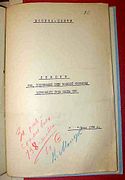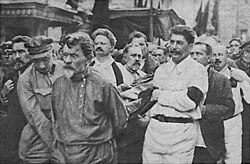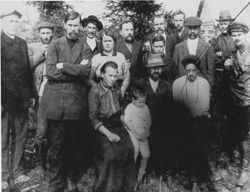Katyn - decision of massacre p1
TOP SECRET
From the Central Committee of the Communist Party of the Soviet Union to comrade STALIN
In the NKVD POW camps and in the prisons of the western oblasts of Ukraine and Belorussia there is currently a large number of former officers of the Polish army, former Polish police officers and employees of intelligence agencies, members of Polish nationalist c-r (counterrevolutionary) parties, participants in underground c-r rebel organizations, defectors and so on. All of them are implacable enemies of Soviet power and full of hatred for the Soviet system.
POW officers and policemen located in the camps are attempting to continue c-r work and are leading anti-Soviet agitation. Each of them is simply waiting to be freed so they can have the opportunity to actively join the fight against Soviet power.
NKVD agents in the western oblasts of Ukraine and Belorussia have uncovered a number of c-r rebel organizations. In each of these c-r organizations the former officers of the former Polish army and former Polish police officers played an active leadership role.
Among the detained defectors and violators of the state-
(Signatures: In favor - Stalin, Voroshilov, Molotov, Mikoyan)
(In margin: Comrade Kalinin - In favor. Comrade Kaganovich - In favor.)- РГАСПИ Ф. 17 оп. 166 дело 621 лист 130. Подлинник. Scan from http://katyn.ru/index.php?go=Pages&in=view&id=6
- This is a colour photocopy of official document residing in the Russian archive RGASPI, a b/w copy of which had been legally transferred into the property of Polish Government, and first published in Poland in 1992.
Relevante Bilder










































Relevante Artikel
Lasar Moissejewitsch KaganowitschLasar Moissejewitsch Kaganowitsch, eigentlich Lasar Mossjewitsch Kogan, war ein sowjetischer Politiker und einer der engsten Vertrauten von Josef Stalin. .. weiterlesen
Massaker von KatynBeim Massaker von Katyn erschossen Angehörige des sowjetischen Volkskommissariats für Innere Angelegenheiten (NKWD) vom 3. April bis 11. Mai 1940 etwa 4400 gefangene Polen, größtenteils Offiziere, in einem Wald bei Katyn, einem Dorf 20 Kilometer westlich von Smolensk. Diese Tat gehörte zu einer ganzen Reihe von Massenmorden, die im Frühjahr 1940 an mindestens fünf verschiedenen Orten in den Unionsrepubliken Russland, Ukraine und Weißrussland an 22.000 bis 25.000 Berufs- oder Reserveoffizieren, Polizisten und Intellektuellen verübt wurden. Die Opfer zählten überwiegend zu den Vorkriegseliten der unabhängigen Zweiten Polnischen Republik. Die Entscheidung zu diesen Massenmorden fällte der sowjetische Diktator Josef Stalin, das Politbüro der Kommunistischen Partei bestätigte die Hinrichtungsbefehle. Der Name des Dorfes Katyn, polnisch Katyń, repräsentiert in Polen diese Mordreihe und wurde zum nationalen Symbol für das Leiden Polens unter sowjetischer Herrschaft im Zweiten Weltkrieg. .. weiterlesen
Josef StalinJosef Wissarionowitsch Stalin war ein sowjetischer kommunistischer Politiker georgischer Herkunft und Diktator der Sowjetunion von 1927 bis 1953. Den Kampfnamen Stalin, der nach verschiedenen Deutungen für „der Stählerne“ steht, nahm er 1912 an. .. weiterlesen
